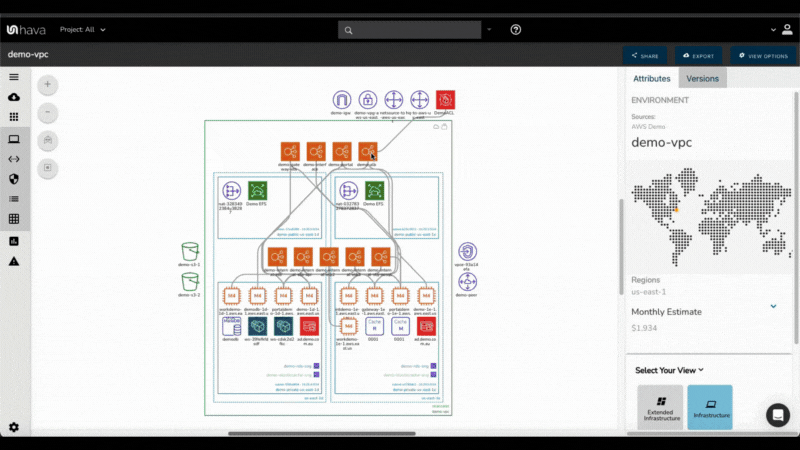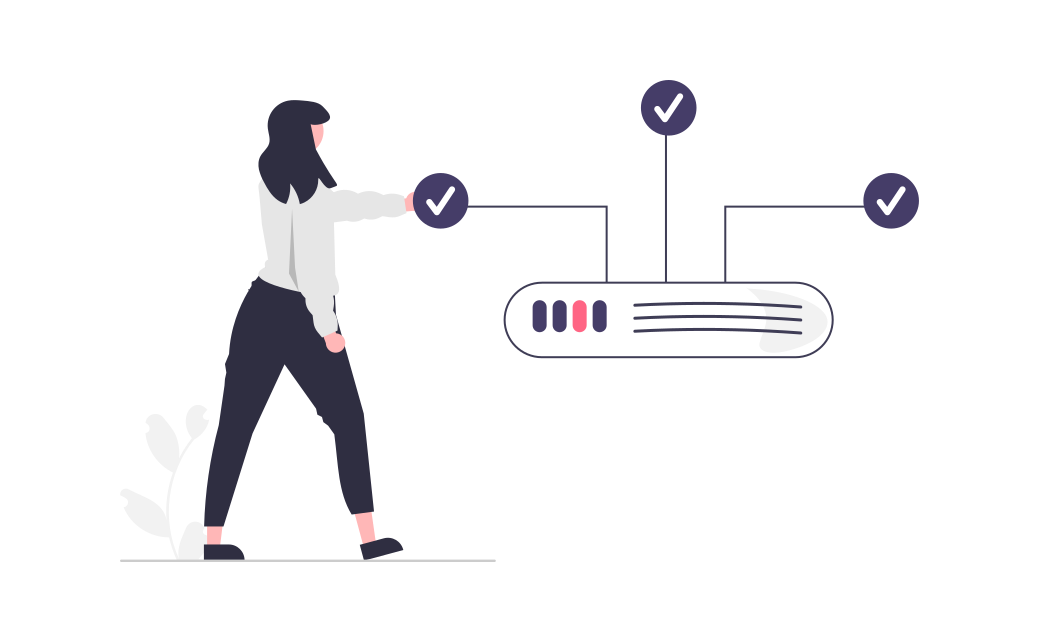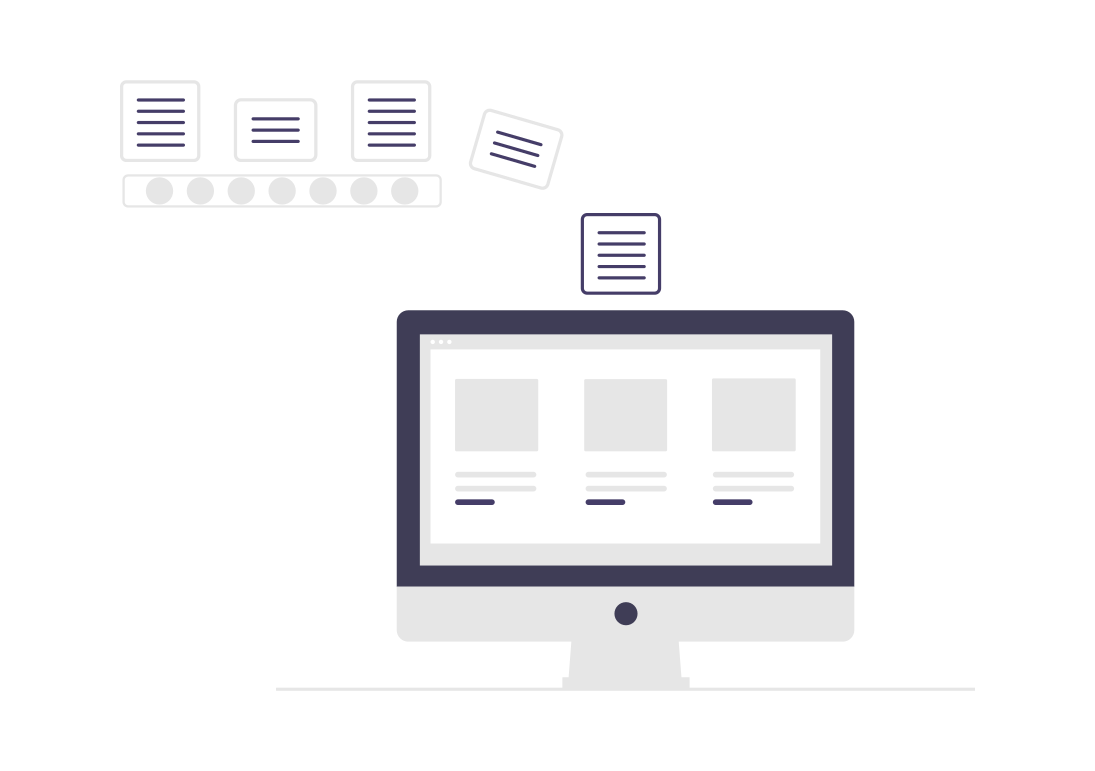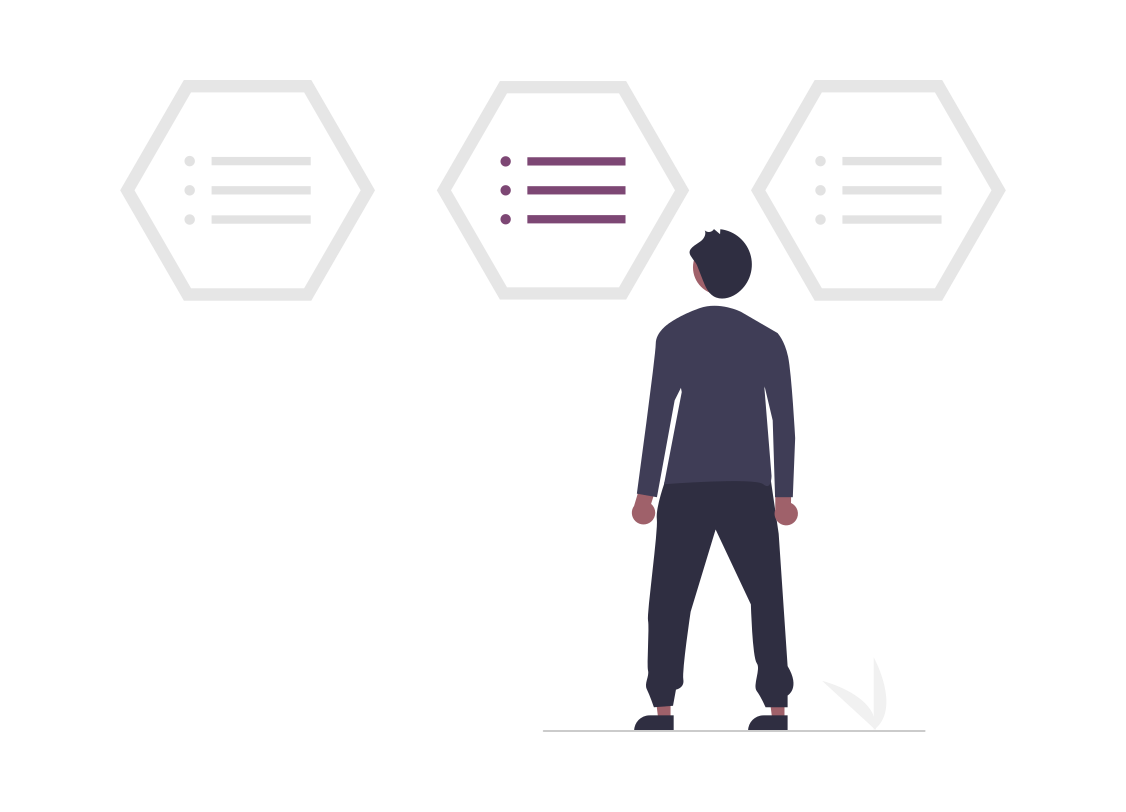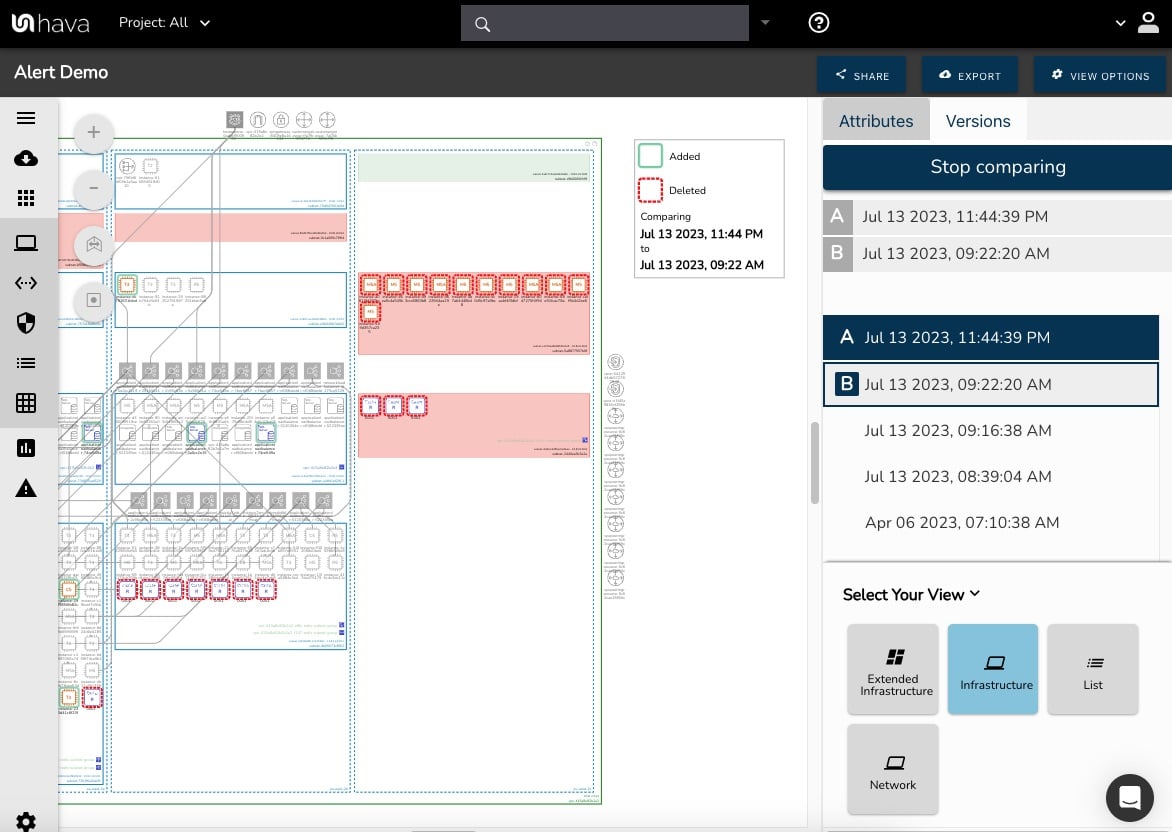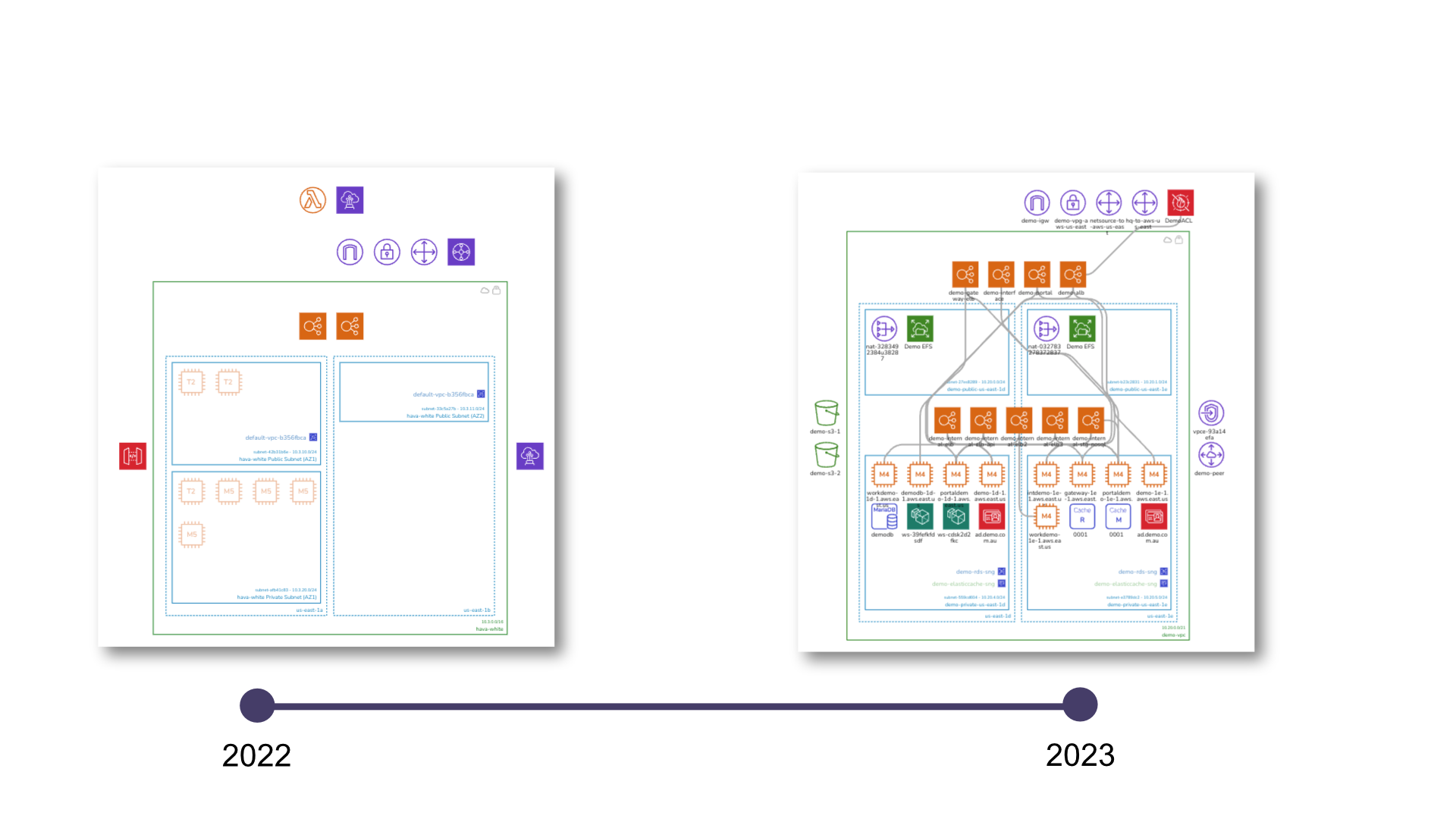In the vast landscape of cloud computing, finding the cost culprit can often feel like finding a needle in a haystack. This is where Hava.io comes in, providing a solution that makes the needle shine.
Hava.io, a leading cloud visualization platform, brings context to your cloud cost observability. It does this by generating interactive environment diagrams that stay up-to-date on auto-pilot and record changes to infrastructure. This visual approach helps Managed Service Providers (MSPs), DevOps, FinOps and professional services organizations to quickly identify expensive resources within hundreds of cloud environments.
When cost alerts start pinging away or budgets start to blow out, MSPs can use Hava to zero in on the culprit and provide the required context around that particular resource. They can respond by creating custom views using tags to show everything associated with a particular application or project and a history of the changes. They can then provide the customer with a link to the diagram showing what is running, what they have reviewed, and what they should consider next.
Professional services teams face similar challenges. When costs have gone up and the client wants a review, using Hava, they can provide current and previous infrastructure visualization for all their running environments. They can use Hava’s list view to show all running resources in each virtual network sorted from the most expensive so they can see with granular detail exactly what is costing what.
In conclusion, all AWS, Azure, and GCP cloud users should use Hava.io to bring context to their cloud cost observability. By understanding the context behind each resource, users can optimize their cloud resources, reduce costs, and improve decision-making.
2 min read
Finding Your Cloud Cost Culprit in a Hay Stack with Hava
By Team Hava on Aug 25, 2023 5:08:00 PM
Topics: aws azure gcp FinOps
2 min read
Hava's Unique Features: From Auto Updates to Diagram Versioning
By Team Hava on Aug 23, 2023 7:44:22 AM
If you work with cloud architecture you know that understanding and visualizing complex architecture is paramount. As businesses migrate and expand their cloud operations, the need for tools that can simplify and automate the visualization process becomes evident. Enter Hava, a revolutionary tool designed to address these challenges head-on for anyone building on AWS, Azure or GCP.
1. Automated Updates: One of the standout features of Hava is its ability to automatically update cloud diagrams. Unlike traditional methods that require manual intervention every time there's a change in the architecture, Hava continuously syncs with your cloud environment. This ensures that your diagrams always represent the current state of your infrastructure, eliminating outdated or inaccurate representations.
2. Diagram Versioning: Cloud architectures are dynamic, with changes occurring frequently. Hava recognizes the importance of tracking these changes over time. Every time a diagram is updated, Hava retains the previous version in a version history. This allows users to go back and inspect previous configurations, providing invaluable insights for audits, troubleshooting, or understanding the evolution of the architecture.
3. Diff Diagrams: Beyond just versioning, Hava offers a unique 'diff' feature. Users can compare any two versions of a diagram, and Hava will highlight the differences, showing what has been added, removed, or modified. This comparative view is especially useful for quickly understanding the impact of recent changes.
4. Interactive Diagrams: Hava's diagrams are not static images. They are interactive, allowing users to click on individual components, be it a VPC, subnet, or any other resource, to view detailed attributes. This interactivity ensures that users have all the information they need at their fingertips, without having to switch between tools or consoles.
5. Security Visualization: In the age of cyber threats, understanding security configurations is crucial. Hava provides visual representations of AWS or Azure security setups, enabling teams to quickly identify potential vulnerabilities, such as open ports or misconfigured ingress points.
6. Customization and Filtering: While Hava's automated diagrams are comprehensive, there are times when users might need a more focused view. Hava's search and filter tools allow for the creation of custom diagrams based on specific criteria, be it by region, resource type, or tags. This flexibility ensures that users always have the right view for their needs.
In conclusion, Hava is not just another cloud diagramming tool. It's a comprehensive solution designed to address the unique challenges of visualizing cloud architecture hands free. With features like automated updates, versioning, and interactive diagrams, Hava stands out as an indispensable asset for any organization looking to simplify and enhance their cloud visualization processes.
Topics: aws azure gcp
2 min read
Understanding Cloud Architecture | The Importance of Accurate Diagrams
By Team Hava on Aug 22, 2023 7:29:59 AM
Cloud computing has revolutionized the way businesses operate, offering flexibility, scalability, and cost-effectiveness. As organizations increasingly adopt cloud solutions, understanding the underlying architecture becomes crucial. This is where accurate cloud diagrams play an indispensable role.
Cloud diagrams provide a visual representation of an organization's cloud environment, detailing how various components and services are interconnected. They serve as a roadmap, guiding engineers, developers, and IT professionals through the complexities of cloud configurations. But why are these diagrams so vital?
1. Facilitating Onboarding and Training
Topics: aws azure gcp
2 min read
The Challenges of Manual Cloud Diagrams and How Automation Can Help
By Team Hava on Aug 22, 2023 7:13:30 AM
Cloud computing has rapidly become the backbone of countless businesses, powering their operations and facilitating growth. As companies increasingly migrate to the cloud, understanding their cloud architecture becomes paramount. This is where cloud diagrams come into play. These visual representations provide a clear picture of how various cloud components interact, making it easier for engineers, developers, and decision-makers to comprehend the intricacies of their cloud environment.
However, creating these diagrams manually presents a host of challenges. For starters, the dynamic nature of the cloud means that configurations and architectures are constantly evolving. Keeping up with these changes and ensuring that diagrams are always up-to-date can be a herculean task. Engineers often find themselves spending hours, if not days, console hopping between environments, cloud accounts, and even vendors to get a comprehensive view of their cloud architecture. This not only consumes valuable time but also increases the risk of human error, leading to diagrams that might be outdated or inaccurate.
Moreover, the manual process of drawing and updating these diagrams is tedious. It requires a meticulous attention to detail, as even a minor oversight can lead to significant misinterpretations. For businesses with complex architectures or those operating in multi-cloud environments, the challenge is even more pronounced. The sheer volume of components and their interconnections can make manual diagramming a nightmare.
This is where automation comes to the rescue. Tools like Hava are revolutionizing the way companies approach cloud diagramming. By automating the process, these tools ensure that diagrams are always reflective of the current state of the cloud architecture. They eliminate the need for manual updates, thereby reducing the risk of human error. With just a few clicks, engineers can get accurate, up-to-date diagrams that provide a holistic view of their cloud environment.
In addition, automation brings with it the advantage of scalability. Whether you're dealing with a simple cloud setup or a complex multi-cloud architecture, automated tools can handle it with ease, ensuring that your diagrams are always comprehensive and detailed.
While manual cloud diagramming has its place, the challenges it presents in today's fast-paced cloud environment are undeniable. Automation offers a way out, providing businesses with accurate, up-to-date, and scalable diagrams that can drive informed decision-making. As cloud architectures continue to evolve, embracing automation in diagramming will be the key to staying ahead of the curve by improving the availability and accuracy of your cloud diagrams.
Topics: aws azure gcp
2 min read
Exploring Hava's Deep Search Function: A Key Tool for Cloud Infrastructure Maintenance
By Team Hava on Aug 21, 2023 5:30:00 AM
The ability to quickly locate resources is crucial for effective cloud maintenance and troubleshooting. With the increasing complexity of cloud environments, this task can be challenging. However, Hava.io offers a solution to this problem with its deep search function.
Topics: aws azure gcp
2 min read
Pretty Architecture Diagrams Showing Poor Cloud Architecture Decisions
By Team Hava on Aug 17, 2023 4:51:00 PM
Pretty Hava Diagrams Showing Poor Architectural Decisions
Topics: aws azure gcp FinOps
2 min read
Finding the Top 5 Culprits When Cloud Environment Costs Spike
By Alan Blackmore on Aug 7, 2023 4:26:00 PM
How to Find the Top 5 Culprits When Environment Costs Spike using Hava.io
Topics: aws azure gcp FinOps
2 min read
Strategies to Reduce Cloud Architectural Drift and Maintain Security
By Team Hava on Aug 7, 2023 6:00:00 AM
Cloud architectural drift, the divergence between the actual state of a cloud environment and its intended configuration, poses significant challenges to cloud security. It can lead to unauthorized changes, security vulnerabilities, and operational inefficiencies. Therefore, implementing strategies to minimize infrastructure resource drift is crucial for maintaining cloud security.
Firstly, adopting Infrastructure as Code (IaC) is a key strategy. IaC allows the infrastructure to be defined and managed as code, providing a consistent reference point for the desired state of the environment. Regularly running IaC scripts can automatically revert any unauthorized changes, effectively minimizing drift.
Secondly, implementing strict access controls can prevent unauthorized changes that lead to drift. By limiting who can make changes to the cloud environment and requiring approval for changes, organizations can maintain tighter control over their infrastructure.
Thirdly, regular auditing of the cloud environment is essential. Audits can identify changes that have occurred, allowing for the detection and remediation of drift. Tools that provide real-time visibility into the state of the infrastructure can be particularly useful for this purpose.
Additionally, fostering a culture of collaboration and transparency among development teams can help minimize drift. When teams understand the current state of the infrastructure and collaborate on changes, the risk of conflicting changes leading to drift is reduced.
Finally, continuous learning and improvement should be encouraged. As cloud environments and best practices evolve, strategies to minimize drift should be regularly reviewed and updated.
In conclusion, minimizing infrastructure drift is crucial for maintaining cloud security. By adopting IaC, implementing strict access controls, regularly auditing the environment, fostering collaboration, and encouraging continuous improvement, organizations can effectively manage drift and maintain a secure and efficient cloud environment.
Topics: aws azure gcp
2 min read
The Role of IaC in Managing Cloud Architectural Drift
By Team Hava on Aug 3, 2023 2:09:28 PM
Infrastructure as Code (IaC) is a key component in modern cloud environments. It allows developers to automate the provisioning and management of cloud resources using code, leading to more efficient and reliable deployments. However, when it comes to managing cloud architectural drift, IaC plays an even more critical role.
Cloud architectural drift refers to the divergence between the actual state of a cloud environment and its intended state as defined by IaC scripts. This drift can occur due to manual changes, conflicting IaC scripts, or other factors. If left unchecked, it can lead to security vulnerabilities, operational inefficiencies, and other issues.
IaC can help manage cloud architectural drift in several ways. Firstly, by defining the desired state of the cloud environment in code, IaC provides a clear and consistent reference point. Any deviations from this reference point can be easily identified, allowing for quick detection of drift.
Secondly, IaC enables automated remediation of drift. By running IaC scripts regularly, any changes to the cloud environment that were not made through IaC can be automatically reverted, bringing the environment back to its desired state. This not only reduces the risk of drift but also frees up valuable time for IT teams.
Finally, IaC promotes transparency and collaboration. With the entire infrastructure defined in code, it's easier for teams to understand the current state of the environment, track changes, and collaborate on updates. This can help prevent conflicting changes that could lead to drift.
In conclusion, IaC is an essential tool for managing cloud architectural drift. By defining the desired state of the cloud environment in code, enabling automated remediation, and promoting transparency, IaC can help organizations maintain control over their cloud environments, reduce risks, and improve operational efficiency.
Topics: aws azure gcp drift
2 min read
Understanding the Causes and Effects of Cloud Infrastructure Drift
By Team Hava on Aug 3, 2023 1:17:37 PM
Infrastructure drift is a common challenge faced by organizations that rely heavily on cloud services. It refers to the divergence of the actual state of cloud resources from their prescribed Infrastructure as Code (IaC) configuration. This drift can lead to potential security risks and operational challenges, making it crucial for businesses to understand its causes and effects.
The causes of infrastructure drift are varied and can occur due to several factors. Manual changes, such as configuration modifications, software updates, hardware malfunctions, and human error, can all lead to drift. These changes can impact the production environment, leading to discrepancies between the actual and intended state of the infrastructure.
Another common cause of infrastructure drift is conflicting Infrastructure as Code (IaC) code. This can occur when multiple development teams are working on the same infrastructure, leading to inconsistencies and drift. Poor practices, inappropriate permissions, and overlapping team boundaries can further contribute to drift. These issues can lead to unmanaged resources, creating a gap between the actual and desired state of the infrastructure.
The effects of infrastructure drift can be severe and far-reaching. Unmanaged drift can lead to security breaches, ransomware attacks, financial losses, increased resource costs, and increased support costs. It can also cause deployment failures due to configuration issues. These consequences can greatly affect critical cloud services and cloud security in cloud environments.
One of the key factors contributing to deployment failure is infrastructure drift. Therefore, managing infrastructure drift is essential to maintain system stability. Alterations to the configuration of code can potentially lead to infrastructure failure, causing infrastructure drift.
In conclusion, understanding the causes and effects of infrastructure drift is crucial for organizations relying on cloud services. By identifying the factors contributing to drift and the potential consequences of unmanaged drift, organizations can implement effective strategies to manage drift. This can help maintain the security and reliability of their cloud infrastructure, ensuring smooth operations and avoiding costly security breaches.




